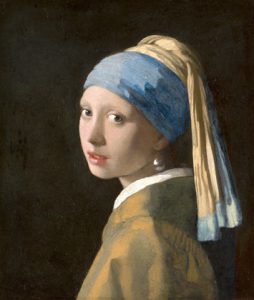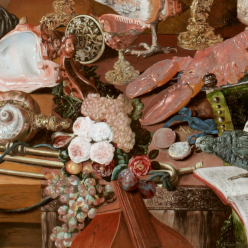
Oil on canvas.
Mauritshuis, inv. no. 670
One of the most captivating paintings of the Dutch Golden Age, Johannes Vermeer’s Girl with a Pearl Earringis a troniefeaturing a beautiful young woman wearing foreign dress, a blue and yellow turban, and an impossibly large pearl earring. As a tronie, the painting depicts an imaginary figure. She appears to be either turning away from or facing the viewer, at once foreign and intimate. Her luminescent pearl earring lends the painting an otherworldly quality and signals the broader Dutch obsession with pearls in the 17th century.
Vermeer was a technical master of light and reflections. His other paintings depict figures in enclosed spaces with singular sources of light. He included multiple layers of oil paint to produce a luminous sfumatoeffect, a hazy contour. Girl with a Pearl Earringembodies Vermeer’s artistic prowess. The massive pearl earring catches the light and refracts it across the woman’s beautiful face. Her slightly parted lips contain a sheen in the upper left corner, demonstrating how the pearl illuminates her sensuous face. The interplay of light and darkness creates an intimate atmosphere between the viewer and the painting’s enigmatic figure.
A famed painter of the Dutch Golden Age, Vermeer produced art at the peak of the Dutch maritime empire. The Dutch ended war with Spain in the 1648 Treaty of Münster, enabling the Dutch to operate freely in Eastern markets. Throughout the 17thcentury, the Dutch expanded trade through the Dutch East India Company (VOC) and gained a monopoly on the pearl trade in the East. Pearls became popular status symbols in the Netherlands, embodying the exotic beauty of the East. Just as the tulipmaniacraze saw Dutch elites paying exorbitant prices for tulips, the Dutch Golden Age saw elite similarly pining for pearls. Pearls contained a foreign mystique and were thus desirable objects. Vermeer often painted pearls in conjunction with women, drawing a parallel between the pearls’ milky beauty with the ideal woman’s moral purity.
Girl with a Pearl Earringis notable not only for its superb painting technique, but also for its reflection of European self-image. The woman’s turban, dress, and pearl earring are all symbols of foreignness to the European viewer, yet the woman’s beautiful European face is familiar. The figure in Girl with a Pearl Earringembodies Europe— specifically the Dutch— on the precipice of a new, globalist age. Conflating European standards of beauty with Eastern “exoticism,” the Europeans came to embrace foreign influences. Girl with a Pearl Earring’s tension between Eastern and Western beauty is what captivates viewers.
Sources:
Atlas of World History. Edited by Patrick K. O’Brien. New York: Oxford UP, 2002.
Brook, Timothy. Vermeer’s Hat: The Seventeenth Century and the Dawn of the Global World. London: Bloomsbury Press, 2008.
Gifford, E. Melanie. “Painting Light: Recent Observations on Vermeer’s Technique.” In Vermeer Studies, edited by Ivan Gaskell and Michiel Jonker, 185- 199. Washington: National Gallery of Art, 1998.
Price, J.L. Dutch Culture in the Golden Age. Reaction Books, 2011.
Sluiter, Engel. “Dutch Maritime Power and the Colonial Status Quo, 1585- 1641.” Pacific Historical Review11, no. 1 (1942). Accessed November 29, 2018. http://penelope.uchicago.edu/Thayer/E/Journals/PacHR/11/1/Dutch_Maritime_power_and_the_Colonial_Status_Quo_1585_to_1641*.html.
Vermeer, Johannes. Girl with a Pearl Earring. 1665. Oil on canvas. Mauritshuis, the Hague. November, 13, 2018. https://www.mauritshuis.nl/en/discover/mauritshuis/masterpieces-from-the-mauritshuis/girl-with-a-pearl-earring-670/detailgegevens/.

